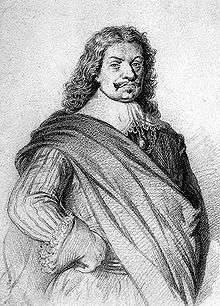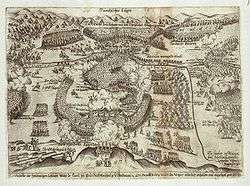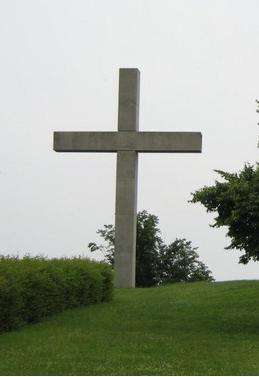Battle of Saint Gotthard (1664)
| Battle of Saint Gotthard | |||||||
|---|---|---|---|---|---|---|---|
| Part of the Austro-Turkish War (1663–1664) | |||||||
.jpg) Battle of Saint Gotthard | |||||||
| |||||||
| Belligerents | |||||||
|
League of the Rhine: | |||||||
| Commanders and leaders | |||||||
|
|
| ||||||
| Strength | |||||||
| ~26-28,000,[1] or 40,000[2] |
~ 50,000-60,000 (30,000 remained unengaged[3]), or ~60,000 janissaries, and sipahi 60-90,000 irregular[1] | ||||||
| Casualties and losses | |||||||
| 2-6,000 | 16-22,000[1] | ||||||
The Battle of Saint Gotthard (Hungarian: Szentgotthárd; Turkish: Saint Gotthard Muharebesi; German: Schlacht bei Mogersdorf and Schlacht bei St. Gotthard; French: Bataille de Saint-Gothard) was fought on August 1, 1664 as part of the Austro-Turkish War (1663-1664), between an Habsburg army led by Raimondo Montecuccoli, Jean de Coligny-Saligny, Wolfgang Julius, Count of Hohenlohe-Neuenstein, Prince Leopold of Baden, Georg Friedrich of Waldeck and an Ottoman army under the command of Köprülü Fazıl Ahmed Paşa.
The battle took place near Szentgotthárd and Mogersdorf in Western Hungary, near the present-day Austro-Hungarian border and is known as the Battle of Mogersdorf in Austria. The Turks were militarily defeated but were able to negotiate the Peace of Vasvár, which was highly favorable to them.[4]
Preparations
Ottoman dominance in Hungary began with the Battle of Mohács in 1526, which resulted in the conquest of most of Hungary by Suleiman the Magnificent. Meanwhile, the parts of Hungary that remained under Austrian control became known as Royal Hungary. Although the Ottomans had been in relative decline since the death of Suleiman I, Ottoman power saw a resurgence under the extremely capable Köprülü family who sought to destroy the Austrian Habsburgs once and for all. They found their casus belli when the Habsburgs supported a Transylvanian rebellion against Ottoman rule.
Transylvania had escaped Ottoman conquest during the invasion of Hungary and retained its independence by playing off of their powerful neighbors: Poland, Austria and the Ottomans. They recognized Ottoman suzerainty and paid a tribute to the Porte but were given political and religious autonomy in return. In 1658, seeking new land for his principality, Prince George Rákóczy II invaded Poland with his Swedish allies in the Second Northern War. After initial success, he was defeated by the Poles and fled back to Transylvania. On hearing about Rákóczy's unauthorized war, the Ottomans declared war on their vassal. It was not long before Grand Vizier Köprülü Mehmed Pasha (Vizier 1656-1661) defeated Rákóczy and conquered Transylvania. The new Transylvanian prince, János Kemény, fled to Vienna, seeking Austrian support.
Emperor Leopold I, not wishing to see Transylvania fall under direct Ottoman control, sent Montecuccoli into Hungary with his small army. Montecuccoli gave no direct support as he was severely outnumbered by the Ottomans. The Ottomans, meanwhile, completed the conquest of Transylvania and built up their forces in Ottoman Hungary. Leopold I, not wishing to face the Turks alone, summoned the Imperial Diet in January 1663.
The Turks failed to conquer the fortress of Nové Zámky six times, but managed to do so in 1663. It was made the center of an Ottoman province, the Uyvar eyalet in present-day southern Slovakia. Turks and Tatars crossed the Danube in strength in 1663, ravaging Slovakia, Moravia, and Silesia. They took 12,000 slaves in Moravia. Several Turkish divisions reached as far as Olomouc.[5]

Diplomatic efforts
The Austrian victory was achieved more due to diplomatic efforts than military power. Although Leopold personally objected to Protestantism, he had to rely on his Protestant German princes to provide military aid. Even worse was the military aid from France, which was (and continued to be until the Diplomatic Revolution of 1756) Austria's nemesis. Despite numerous objections from some Protestant princes, help was not withheld. The League of the Rhine - a French dominated group of German princes - agreed to send a corps of 6,000 men independently commanded by Count Coligny of France and Prince Johann Philipp of Mainz. By September 1663, Brandenburg and Saxony had also agreed to contingents of their own. In January 1664, the Imperial Diet agreed to raise 21,000 men, although this army did not yet exist other than on paper. The Turks had declared war in April 1663, but were slow in executing their invasion plans.
Battle
Köprülü's army, which might have numbered 120-150,000, probably included some 60,000 Janissaries and sipahis, 60-90,000 azaps, akıncıs, silidars, Tatars and vassals and allegedly 360 guns.

Montecuccoli's army consisted of Austrian, and German forces, Czech infantry, French brigades, approx. 2,000 Croatians, a Piedmontese regiment and few hundred Hungarians.
The Habsburg forces: 5,000 infantry (10 Battalions), 5,900 cavalry (27 escadrons), 10 guns
The Imperial forces: 6,200 infantry (6 Battalions), 1,200 cavalry (9 escadrons), 14 guns
The Rhine forces: 600 infantry (2 Battalions), 300 cavalry (4 escadrons)
The French forces: 3,500 infantry (4 Battalions), 1,750 cavalry (10 escadrons)
Other forces: 2,000 Croat cavalry (out of this a regiment), Hungarian foot soldiers in Szentgotthárd, and Esterházy, Batthyány and Nádasdy regiment's, Czech musketeers and the Italian (Piedmontish) infantry regiment (commander Marchese Pio de Savoya).
The Turks renewed their invasion in the spring of 1664. They besieged, conquered and destroyed Novi Zrin Fortress on the Mura river in northern Croatia at the very beginning of July. Montecuccoli was still waiting for help to arrive, and this delay was key to the defense of Austria. In July 1664 the Imperial forces were assembled and set out for the River Rába, which separated the Ottoman forces from the Austrian duchy itself. If the Turks were allowed to cross, they would threaten both Vienna and Graz. Montecuccoli intercepted the Turks before they crossed the river but the division of command made effective deployment of troops impossible.
On 1 August 1664, Ottoman forces crossed the river near the monastery of Saint Gotthard and beat the Austrians back. Although initially plagued by disunity, Montecuccoli was finally able to convince Coligny and Leopold Wilhelm of Baden-Baden (commander of the Imperial detachment) to mass their forces and attack the Ottoman troops, who were reorganizing in a nearby forest. The attack surprised the Turks, who fled in confusion back to the river, a large number drowning. The confusion caused by the fleeing troops prevented Ahmed Köprülü (Vizier 1661-1676) from sending the rest of his army across the river and he instead retired from the field.

Ottoman casualties were heavy, significantly falling mostly on the elite corps of the army. Köprülü was left with an army of ill-trained irregulars and auxiliaries while Montecuccoli's casualties were light and mostly in the Imperial contingent.

Aftermath
Although many in Europe, especially the Croats and Hungarian nobility, expected the Austrians to finally liberate Hungary once and for all, Leopold abandoned the campaign. Many have criticized him for this decision (both in the past and the present). Although Montecuccoli's army was largely intact, there was no interest among the allies to liberate Hungary. Any invasion of Hungary would undoubtedly have to be done without the help of the French and German troops. Leopold noticed that the French officers had begun to fraternize with the Magyar nobles and encouraged them to rebel against Austrian rule.
In addition, Leopold had always been a member of the "Spanish faction" in Vienna. With the last Spanish Habsburg, Carlos II, about to die at any given moment, Leopold wanted to ensure that his hands were free for the inevitable struggle against Louis XIV of France. Although the liberation of Hungary was a strategic interest of the Habsburgs, it would have to wait until later. Throughout his reign, Leopold had always been more interested in the struggle against France rather than the Ottomans. Therefore, he signed the rather unfavourable Peace of Vasvár, which did not take into account the Battle of Saint Gotthard. The Battle of Saint Gotthard is still significant, however, for it stopped any Ottoman invasion of Austria, which certainly would have prolonged the war and led to a disastrous resolution. The Austrians would also use the twenty-year truce to build up their forces and begin the liberation of Hungary in 1683.
In literature
The battle of Mogersdorf/Szentgotthárd provided Rainer Maria Rilke with the inspiration for his poetic short story, "Lay of the Love and Death of Cornet Christopher Rilke", which was very popular among German and Austrian soldiers during the first half of the 20th century.
See also
Notes
- 1 2 3 Géza Perjés: The Battle of Szentgotthárd (1664), Vasi Szemle (Vas Review), 1964.
- ↑ Black & Murphey, Ottoman Warfare, 1500-1700, pp.48-49 "At the battle of Saint Gotthard in August 1664 Raimondo Montecuccolli, supreme commander of a Habsburg force significantly strengthened by units both from France and the Rhine confederates, still only managed to field an army of some 40,000 men."
- ↑ Wilson, German Armies: War and German Politics, 1648-1806, p. 43 "Energetic recruiting had increased Habsburg forces to 51,000 by February 1664, supported by 9,000 Hungarians, but disease and the need to garrison border fortresses reduced the combined force to 24,450 by the time Montecucolli engaged the 50,000-60,000 strong Ottoman army at the Monastery of St Gotthard on the river Raab on 1 August 1664. [...] Though 30,000 of his troops remained unengaged, the grand visier sensed the battle going against him and decided to retreat, leaving the Christians in possession of the field. Two thousand, mainly Germans, had been lost, along with similar number of fugitives. Turkish losses are not known, but were probably less."
- ↑ Cross and Crescent
- ↑ Olomouc History
References
| Wikimedia Commons has media related to: |
- Jeremy Black & Rhoads Murphey, Ottoman Warfare, 1500-1700, Routledge, 1999.
- Peter H. Wilson, German Armies: War and German Politics, 1648-1806, Routledge, 1998.
- John P. Spielman, Leopold I of Austria (1977) ISBN 0-8135-0836-3
- Charles W. Ingrao, The Habsburg Monarchy 1618-1815 (1994) ISBN 0-521-78505-7
Coordinates: 46°56′30″N 16°13′00″E / 46.94167°N 16.21667°E